The
Families of Anielioka and Berestovitz
This web page is about the German families of
Anielowka and Berestowitz, Volhynia, Russia during the period of 1860 to 1890. The
writings, however, particularly focus on the Remus family and their linkages to
the other families. So the story starts with my great-grandfather August
Wilhelm Remus and great-grandmother Wilhelmina Harwardt.
Click here for the Remus
family tree. My
great-grandfather August Remus came from Neutuchel, West Prussia. Click the History of the Remus
Family in West Prussia for more details. My
great-grandmother Wilhelmina Harwardt came from
Szczepanowo, Poland - just northwest of Posen.
Anielioka
Though some yet unknown fortuitous
circumstances, my great-grandparents August and Wilhelmina Remus migrated
independently to Anielowka, Volhynia
about the same time. There they met and married as shown in their marriage
record; to see the marriage record and something about their lives in Poland
prior to Volhynia click August and Wilhelmine. For the almost 30 years they were in Volhynia, they lived in this and other nearby villages of Berestowitz and Kostopol. The
general area they lived in is shown on this map.

Hard to Read the Map? Click here for the Adobe Acrobat Version.
After the nasty Polish revolution of 1860,
many Germans left Poland for Volhynia for the
personal safety and because the Nobles of Volhynia
were selling land to German farmers (in Poland it was often only leased). The
reason the land became available was that the Russian Czar had freed the
Ukrainian serfs in 1861 and the serfs left the land. The land was too expensive
for the serfs to buy so the Nobles derived no income from the land. Thus the
land from Anielowka to Kostopol
became available and contained many German villages.
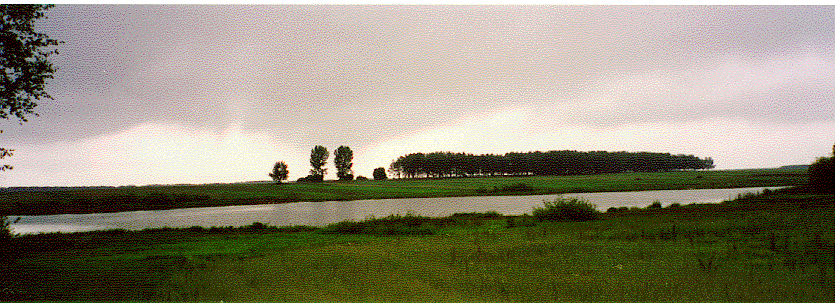
Anielowka was a strassendorf (street
village). That is, the houses of the villages were lined up close to each other
on both sides of the street. Each house had a nearby small garden and out
buildings but the bigger plots of land were on the out
skirts of the village. If you click on the Anielowka Gallery,
you will find pictures of the village including the old lady who told us about
the village, pictures of the farm land and pictures of the graveyard (no German
monuments remained). None of the buildings survived World War II so there are
no remnants of the old German village.
Although my great-grandfather
August lived in Anielowka, he had his business in
nearby Postoina.
This village was quite large but also contained no German artifacts. If you
click on the Anielowka
Gallery, you will also see a picture
of the land around Postoina.
Many families resided in Anielowka
including the Schultz and Bidermann families. These
families remained friends and migrate with the August Remus family to Canada in
1891; August settled in Emerson, Manitoba and the Schultz and Biedermanns in Leduc, Alberta. Click on the Schultz family
or Wilhelm Biederman(n)
family to see his friend's family
trees (they were in-laws, too). Click on manifest to
see who was on the HMS Polynesian (the so called, "rolly
polly", going to Canada in 1891.
Berestowitz
My great-grandparents August and Wilhelmine moved to Berestowitz
in 1874 with their children Wilhelm,
August, Rudolph, and Karl. This village is 10 or 15 miles east of Anielowka on the same road as Anielowka
and Postoina. This village was the location of the
wonderful story about the marriage of August Remus' eldest son Wilhelm to
Gottfried Deutschlander's daughter Maria (the Deutschlanders came from Zwadka near Klodawa and Ozorkow near Lodz in Russian Poland).
To read the story, click the Wilhelm Remus and Maria Deutschlander
Story. Wilhelm and Maria lived in a
house on the main road just to the west of the village (all homes there were
destroyed) - shown here in the map:
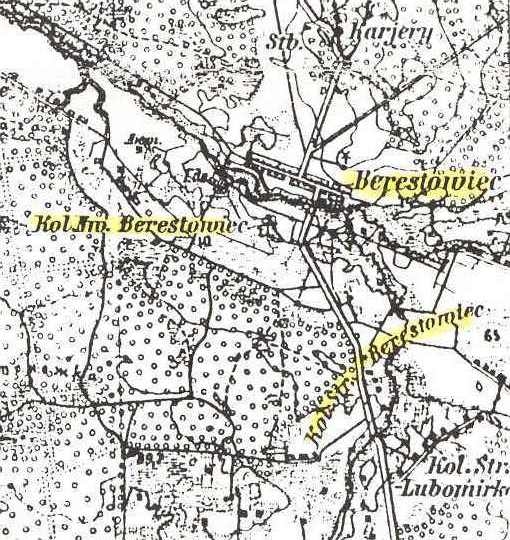
When we arrived in Berestowitz,
a friend of George Maser (a Deutschlander descendent)
hosted a big luncheon for our group at his friend Raisa's
house. The food and drink was wonderful but the high point was her giving me a
plaque honoring the Wilhelm Remus and Maria Deutschlander
story. Following is a picture of Raisa greeting the
group in the traditional Ukrainian way (a special salt cake) and a picture of
me receiving the plaque.
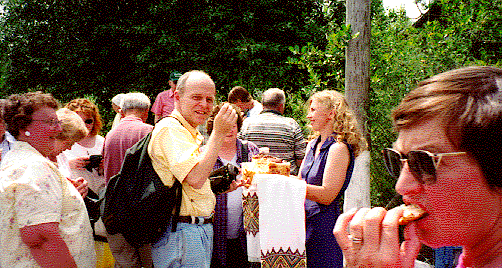
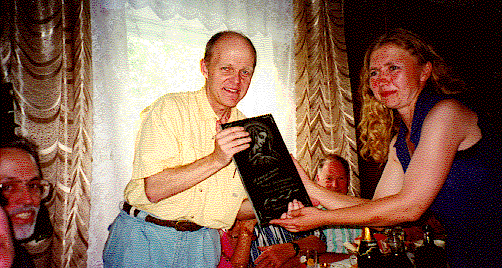
Except for 1879 to 1883 when August and Wilhelmine lived near Kostopol,
the Remus family lived in Berestowitz. This village
too was a strassendorf originally. However the
original village was totally destroyed in World War II and the new village was build in a different place than the old German village. The
story is that the villagers would not tell the location of the anti-Nazi
partisans and the Nazi's burned the village (some of the houses had people in
them). Even the old cemetery is gone and the German remains reburied in the new
village cemetery. Click WW II villagers
to find out who lived in the village the prior to the Second World War. In the Berestowitz Gallery I
have pictures of the location of the old German village.
In Berestowitz
Pauline, Ernestine, Adoph, Edward (my grandfather),
Reinhold, and Maria were born to August and Wilhelmine.
In Berestowitz there also lived a number of families
that later migrated to North America and who were friends with the Remus
family. Click for the family tree of the Deutschlander family and
the Christoph Hopp(e) family. The Deutschlander tree also has information on the Patzer, Domres and the Rapsky families.
Kostopol
From 1879 to 1883 my
great-grandfather August Remus and family lived near Kostopol. August's business (he
tried many businesses in addition to being a wheelwright) was in Kostopol. His son Karl was born there. This village was
destroyed in World War II and rebuilt thereafter. It is a relatively large
village owing to its prominence as a market town and a major rail stop. The
railway station for Kostopol still remains from the
prewar era; it is currently being restored. It must have brought many Germans
to this area and later shipped them to the New World (and also Siberia in both
World Wars).
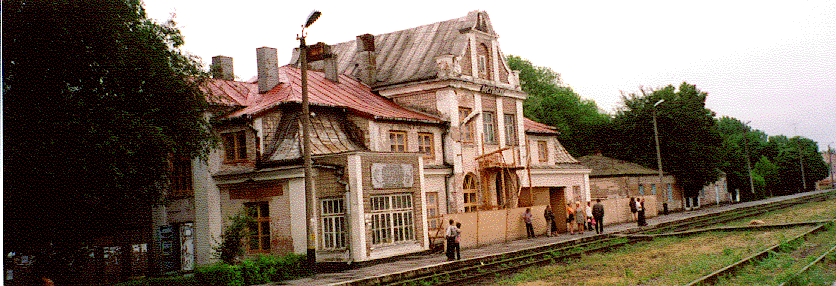
Marcelinhof
The village of Marcelinhof
lies between Kostopol and Berestowitz.
These villages were close enough that the villagers knew and even intermarried.
Here is a picture of a home and garden in that village; the homeowner said this
was the oldest tree in the area so it must have shaded our ancestors.

The Hoppe family lived in this village
including the descendents of Christoph Hoppe, a
friend of the Deutschlander family back in Poland.
The Hoppe family also intermarried with the Deutschlander
family and Remus families. Many of the Hoppes
migrated to the plains of Canada, not far from where August and Wilhelmina
lived. Click Christoph Hoppe and Anna Marianna Deutschlander
(both previously from Ozorkow)
for a family tree. The Kesterke family later
of Berrien County Michigan lived in Marcelinhof as
did Christoph's likely brothers Heinrich and Albert
Hoppe. Here is a picture of old friends Wilhelm Hoppe and wife Justine Domres (left)� (Wilhelm was the son of Christoph Hoppe and Anna Marianna Deutschlander)
with August Remus and Wilhelmine Harwardt
(right) in Canada.

From Marcelinhof
one can see the former site of Lisuch (Lessapol) where the main Lutheran church was for this area.
Wilhelm Remus and Maria Deutschlander were married
there and there is a nice story of their marriage in Lisuch
in the Wilhelm
Remus and Maria Deutschlander Story. All this villages were in a line on the road running
Anielowka, Berestowitz, Marcelinhof, Lessapol, with Kostopol just a bit north of Lessapol
and Marcelinhof. As is told in the above story, in
1892 the August Wilhelm Remus family migrated to Manitoba in 1892. They all
started near Gretna
MB. Eldest son Wilhelm purchased his first farm in Gretna but spent most of
his life in Emerson
MB. Son August settled in Altona MB. Father
August Wilhelm and his other sons moved to SK to homestead around the turn of the century.
Here are turn of the century pictures of the families of August
Wilhelm and his children.
Please
send any information and queries to Bill Remus at
September
25, 2005